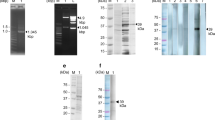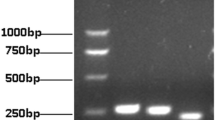Abstract
Paragonimiasis skrjabini is a kind of zoonosis and prevalent in 16 provinces in China, such as Chongqing, Fujian, Sichuan, and Yunnan. However, sensitive and efficient diagnostic methods for the infection are limited. In order to provide a more convenient and simple method for serologic diagnosis, the recombinant P. skrjabini cysteine protease (PsCP) was expressed, purified, and then used to develop an indirect enzyme-linked immunosorbent assay (ELISA) for detecting anti-PsCP antibodies in human. Given the positive/negative cutoff value as 0.606, the maximum dilution of human sera in which anti-PsCP antibodies could be detected was 1:12,800. In addition, the coefficients of variation (CVs) of inter-assay and intra-assay experiments were both below 10 %. Furthermore, the sensitivity of the PsCP-based ELISA was 95.5 %, and the indirect ELISA displays no cross-reactivity with human antisera against Echinococcus granulosus, Taenia solium, Schistosoma japonicum, and Trichinella spiralis, either. In conclusion, recombinant PsCP was readily produced and used to establish a simple PsCP-based ELISA that provided a highly specific and sensitive method for analysis of clinical samples. Besides, the method can also probably be used to diagnose P. skrjabini infection in animals.






Similar content being viewed by others

References
Ahn CS, Na BK, Chung DL, Kim JG, Kim JT, Kong Y (2015) Expression characteristics and specific antibody reactivity of diverse cathepsin F members of Paragonimus westermani. Parasitol Int 64:37–42
Blair D (2014) Paragonimiasis. Adv Exp Med Biol 766:115–152
Chai JY (2013) Paragonimiasis. Handb Clin Neurol 114:283–296
Deshpande SS (1996) Enzyme immunoassay from concept to product development, 1st edn. Kluwer Academic Publishers, Holland
Doanh PN, Horii Y, Nawa Y (2013) Paragonimus and paragonimiasis in Vietnam: an update. Korean J Parasitol 51:621–627
Engvall E, Perlmann P (1971) Enzyme-linked immunosorbent assay (ELISA) quantitative assay of immunoglobulin G. Mol Immunol 8:871–874
Gan XX, Shi XH, Wang Y, Wang PP, Shen HY, Zhu MD, Tang Y, Zhang S (2005) Development of rapid diagnostic (Dot Immunogold Filtration Assay) of detection of antibodies against Paragonimus westermani. Chin J Zoonoses 11:988–990 (in Chinese)
Hua WQ, Yu CX, Yin XR, Qian CY (2011) Application of F-ELISA for immunodiagnosis of schistosomiasis japonica. Chin J Schistosomiasis Control 23:158–162 (in Chinese)
Ikeda T (1998) Antibody responses to fluke cysteine proteinases in Paragonimus- and Fasciola-infected rats. J Helminthol 72(3):187–191
Jacobson RH (1998) Validation of serological assays for diagnosis of infectious diseases. Rev Sci Tech 17:469–526
Keiser J, Utzinger J (2005) Emerging foodborne trematodiasis. Emerg Infect Dis 11:1507–1514
Kim YJ, Lee SM, Choi GE, Hwang SH, Kim HH, Lee EY, Chang CL (2010) Performance of an enzyme-linked immunosorbent assay for detection of Clonorchis sinensis infestation in high- and low-risk groups. J Clin Microbiol 48:2365–2367
Liu Q, Wei F, Liu W, Yang S, Zhang X (2008) Paragonimiasis: an important food-borne zoonosis in China. Trends Parasitol 24:318–323
Ma TJ, Wang KP, Dun GD, Zhang XL (2009) Analysis of the cross-reaction between Paragonimiasis and Schistosomiasis by ELISA in the Three Gorges Reservoir. J Trop Med 9:40–43 (in Chinese)
Middelberg AP (2002) Preparative protein refolding. Trends Biotechnol 20:437–443
Niu JX, Zhang XL, He X, Chen L (2010) Adult antigens of Pagumogonimus skrjabini identified by the serum with paragonimiasis and analysis on their characterizations. Int J Med Parasit Dis 37:136–140 (in Chinese)
Nkouawa A, Sako Y, Itoh S, Kouojip-Mabou A, Nganou CN, Saijo Y, Knapp J, Yamasaki H, Nakao M, Nakaya K, Moyou-Somo R, Ito A (2010) Serological studies of neurologic helminthic infections in rural areas of southwest Cameroon: toxocariasis, cysticercosis and paragonimiasis. Plos Neglect Trop 4(7):e732–e732
Nkouawa A, Sako Y, Moyou-Somo R, Ito A (2011) Serological and molecular tools to detect neurologic parasitic zoonoses in rural Cameroon. Se Asian J Trop Med 42:1365–1374
Park JW, Yoo SB, Oh JH, Yeom JS, Lee YH, Bahk YY, Kim YS, Lim KJ (2008) Diagnosis of vivax malaria using an IgM capture ELISA is a sensitive method, even for low levels of parasitemia. Parasitol Res 103:625–631
Roy P, Praharaj AK, Dubey S (2015) An unusual case of human paragonimiasis. Med J Armed Forces India 71:S60–S62
Schein CH (1990) Solubility as a function of protein structure and solvent components. Biotechnol (N Y) 8:308–317
Song B, Kang XX, Niu JX, Wang Y, Zhang XL (2014) Detection of PsMt01 in different stage of Paragonimus skrjabini by real-time fluorescence quantitative qRT-PCR. Acta Parasitol Med Entomol Sin 21(1):1–5 (in Chinese)
Sugiyama H, Shibata K, Kawakami Y, Arakawa K, Morishima Y, Yamasaki H, Gokuden M, Iwakiri T, Fukumori J (2015) Paragonimiasis due to the consumption of wild boar meat in Japan: contamination levels of lung fluke larvae in muscle samples of wild boars caught in Kagoshima Prefecture. Jpn J Infect Dis 68:536–537
Wang LF, Zhang XL, Niu JX, He X, Chen L (2010) Analysis of excretory-secretory products of adult and larva of Pagumogonimus skrjabini. J Trop Med 10(6):633–636 (in Chinese)
Wu Y, Cheng A, Wang M, Zhang S, Zhu D, Jia AB, Luo BQ, Chen Z, Chen X (2011) Serologic detection of duck enteritis virus using an indirect ELISA based on recombinant UL55 protein. Avian Dis 55:626–632
Yun DH, Chung JY, Chung YB, Bahk YY, Kang SY, Kong Y, Cho SY (2000) Structural and immunological characteristics of a 28-kilodalton cruzipain-like cysteine protease of Paragonimus westermani expressed in the definitive host stage. Clin Diagn Lab Immunol 7:932–939
Zhang XL, Wang Y, Zhang JR, Duan JH (2005) Paragonimus skrjabini in Chongqing region epidemic situation, clinical manifestation, and analysis on 58 misdiagnosed cases. Parasit Infect Dis 3:157–160 (in Chinese)
Zhang XL, Wang Y, Wang GX, Chen WB, He X, Niu H, Li ZL, Chen L, Wang LF (2012) Distribution and clinical features of Paragonimiasis skrjabini in Three Gorges Reservoir Region. Parasitol Int 61:645–649
Zhu YC (2005) Immunodiagnosis and its role in schistosomiasis control in China: a review. Acta Trop 96:130–136
Acknowledgments
We thank the volunteers for providing their sera in this study and thank Professor Ya Zhao from Fourth Military Medical University and Professor Yimei Yang from Dali University, China, for their presentation of the human antisera. And thanks to Luhan Wang from Chongqing Foreign Language School for polishing expression in English. This research was supported by the Natural Science Foundation of Chongqing (CSTC, 2007BB5055). The author’s laboratory was supported in part by grants from the National Natural Science Foundation of China (81271875).
Author information
Authors and Affiliations
Corresponding author
Ethics declarations
All samples used in this study were anonymized. And consent was obtained from all participants enrolled in this study. This study was approved by the Ethics Committee for Health Research, Third Military Medical University, China
Rights and permissions
About this article
Cite this article
Yu, S., Zhang, X., Chen, W. et al. Development of an immunodiagnosis method using recombinant PsCP for detection of Paragonimus skrjabini infection in human. Parasitol Res 116, 377–385 (2017). https://doi.org/10.1007/s00436-016-5300-2
Received:
Accepted:
Published:
Issue Date:
DOI: https://doi.org/10.1007/s00436-016-5300-2



